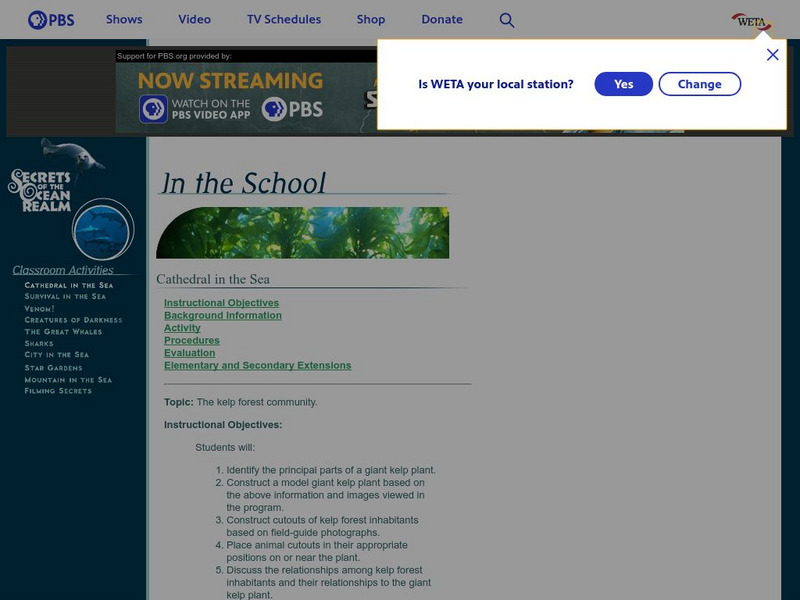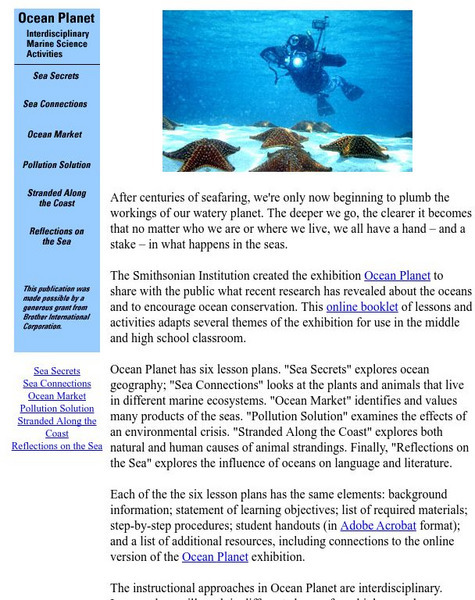Scholastic
Scholastic: Ocean Life
Learn about leatherback turtles and dusky dolphins with the Earthwatch research teams in Costa Rica and New Zealand. Choose which animal you would like to learn more about then read field reports, meet a researcher, become a researcher...
Tramline
Tramline, Inc.: Virtual Ocean Field Trip
In this enchanting site, students will learn basic principles about oceans and will be introduced to an assortment of sea life, both plant and animal. Other interesting ocean links can be found on the teacher resource section of this link.
NOAA
Noaa: National Ocean Service Education: Estuaries
Illustrated tutorial explains estuary ecosystems. Animations and illustrations help students become more familiar with the plant and animal communities which make up this coastal habitat.
USA Today
Usa Today Weather: Understanding Storms and Fronts
Discusses air pressure, fronts, and storm formation. Links on page to well-illustrated and animated additional information.
Woods Hole Oceanographic Institution
Woods Hole Oceanographic Institution: Tsunami: An Interactive Guide
A complete, interactive learning activity covering the science of tsunamis, preparedness, research, and historical tsunamis. Excellent animations and real, historical recordings of survivors allow the learner to experience what happens...
Georgia Aquarium
Georgia Aquarium: Pencil Urchin
Use this animal guide to learn the scientific name and discover the habitat, diet, conservation status, and physical and special characteristics of the pencil urchin.
Georgia Aquarium
Georgia Aquarium: Variegated Urchin
Use this animal guide to learn the scientific name and discover the habitat, diet, conservation status, physical and other unique characteristics of the variegated urchin.
PBS
Pbs Teachers:cathedral in the Sea: Construct a Model Kelp Forest
Investigate the relationships among kelp forest inhabitants and their relationships to the giant kelp plant. List the parts of a giant kelp plant and construct a model of a kelp forest habitat.
PBS
Pbs Learning Media: Scent of an Alewife
This video segment from NOVA: "Sea Behind the Dunes" tracks the return of spawning alewife fish from the open ocean back to the freshwater streams and ponds where they were born. [3:34]
PBS
Pbs Learning Media: The Cuban Crab Migration
In this video segment from Nature, crabs face numerous obstacles in their migration from their forest home to the Caribbean Sea. [4:09]
PBS
Pbs Learning Media: Tracking Polar Bears
In this interactive activity adapted from the USGS Alaska Science Center, students will track the movements of a polar bear as it migrates across the changing Arctic sea ice and compare the paths of four different polar bears.
PBS
Pbs Learning Media: Arctic Ice Extent, 1999 2016
Scientists study sea ice extent closely because it influences global climate. Follow the decline in Arctic sea ice in this animation adapted from NASA showing the yearly maximum and minimum sea ice extents from 1999 to 2016. Resources...
Other
Black Hills Institute of Geological Research, Inc.: The Archelon
The Archelon was the largest sea turtle ever to exist. The best specimen found, on display in Vienna, would have been fifteen feet, or four and a half meters, long when alive, and likely weighed two and a quarter tons, or 2,200...
Indiana University
Indiana Univ. Bloomington: Geo Notes: Crinoids: Ancient Versus Modern Forms [Pdf]
Presents some facts about crinoids, a marine animal abundant during the Paleozoic Era, with many fossil species present in Indiana. This animal can still be found in the Caribbean Sea today.
Smithsonian Institution
Smithsonian Education: Ocean Planet
A series of lesson plans designed to be used with the Smithsonian Ocean Planet exhibit (available online). Lesson topics include marine ecosystems, pollution of ocean water, animal strandings, and literature.
NASA
Nasa: Our Restless Planet
This animation library is a great resource for a diverse list of earth science topics including: tsunamis, land subsidence, magnetic fields, volcanoes earthquakes, floods, and sea level changes.
Biology 4 kids
Biology4 Kids: Sponges the First Invertebrate
Find out about some the most simple organisms in the Animal Kingdom, the sponges.
TED Talks
Ted: Ted Ed: How Squids Outsmart Their Predators
Carly Anne York explains how the stealthy cephalopods have mastered deep sea survival.
Sea World Parks & Entertainment
Sea World: Animal Bytes: African Hedgehog
Brief, but concise resource contains helpful information on this little creature. Provides scientific classification of the African hedgehog, fast facts, fun facts as well as additional information on ecology and conservation.
PBS
Pbs Learning Media: Ouch
Students are asked to explain how human actions have hurt the eagle and the sea turrtles.
Other
Discovery Kids: Jimi Rock Undersea Adventures
Students can learn about the world's oceans in this safe, online, undersea world. Visit virtual dive sites, create characters, and play aquatic-themed games. Students can play some games free, or they can sign up for a membership for a...
PBS
Pbs Nature: Otters
Discover more about how otters live, what they eat and how they socialize when you visit this informative resource. This condensed site will benefit students who need help narrowing their research information.
University of California
Ucmp: Introduction to Ctenophora
This is an advanced level review of the biology of these organisms. The opening photographs are worth seeing!
E-learning for Kids
E Learning for Kids: Science: Antilles: How Can We Classify Animals?
Naomi teaches diving and meets all kinds of animals underwater. Join her and learn about grouping animals.
Other popular searches
- Sea Prehistoric Animals
- Sea Animal Life Cycle
- Sea Animal Research
- Animal Under the Sea
- Animals. Sea
- Sea Animal Art
- Sea Animal Research Projects
- Animals Sea
- Sea and Land Animals
- Sea Animal Game
- Sea Animal Defenses
- Sea Animal Lesson Plans














